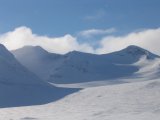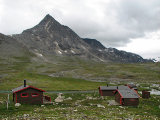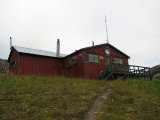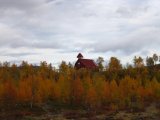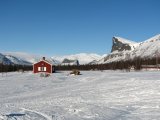There are a number of associations of various kinds and sizes that either operate in or are concerned with the fjelds, or dedicate themselves to outdoor life and nature protection in general. Here I present a selection of them, together with a list of links to other websites, Swedish and international, that may be of interest to explore. At the end you will also find links to transport companies of various kinds.
 |
Svenska Turistföreningen (STF)www.svenskaturistforeningen.se  |
The Swedish Tourist Association is one of Sweden's largest non-profit organizations, counting some 240,000 people among its members. Its motto is Känn ditt land (Know your country), and its stated purpose is to ”further Swedish tourism and spread knowledge about the country and its people”. Today the association runs around 200 hostels and hotels, 10+ fjeld stations, and over 40 cottage sites most of which are situated more or less in the middle of nowhere. Members are eligible for substantial discounts at both the hostels and especially the fjeld facilities, and these also apply to members of the Norwegian (see below) and Icelandic tourist associations, provided that they can display a valid membership card or equivalent.
Founded by a group of geology students in Uppsala in 1885, STF quickly became a pioneer of the burgeoning fjeld tourism in Sweden, much thanks to the construction of the railroad through the northern parts of the country in the late 19th century. In 1888 the young association erected its first building in the fjelds, in the form of a small hut at Varvvekjåhkå beneath Sulidälbmá, which at the time was believed to be the highest mountain in Sweden (not only are there several higher peaks, but the highest summit of this massif actually lies in Norway). During the following years more huts were built in various places along the range, including one close to Sylarna in Jämtland, and towards the end of the century actual cabins started showing up as well.
STF also took it upon itself to establish marked trails along suitable routes in popular areas and acquired rowing boats for water passages, and the early 20th century saw the start of the era of what would become the present-day fjeld stations. In 1927 the marking of the famed Kungsleden (Royal Trail) between Abisko and Kvikkjokk was completed, and in 1933 the first hostel saw the light of day in Gränna.
Throughout the 1900s STF expanded its network of facilities, and made improvements to those already present; the first cottage wardens entered the picture in the 1960s, and public arrangements of various kinds abounded. 1977 marked a major change in the state of affairs, for that year the Swedish Environmental Protection Agency took over the custodianship of the trail system in the fjelds, the majority of which had been created – and up until then cared for – by STF. Nowadays the hostels serve as the association's defining branch to most people, but its fjeld roots are clearly visible in its publications and arrangements catalogue, and to this day STF has its hands (or at least a finger) in most things to do with the Swedish fjelds once one gets beyond the large resorts.
 |
Den Norske Turistförening (DNT)www.dnt.no    |
The Norwegian Trekking Association is Norway's largest outdoor organization with over 300,000 members, and is similar in nature to STF – its stated purpose is ”to facilitate and develop tourist life in this country”. It is, however, older (founded in 1868) and unlike its Swedish counterpart it has no hostel branch; it deals almost exclusively with the fjelds and everything around them. Norway is more mountainous than Sweden and the infrastructure – new or old – reaches further into the valleys and fjords, whereas in Sweden it used to be quite an expedition in itself just to get to the fjelds in the first place. As a consequence trekking took an earlier hold in Norway, and DNT was established to support the growing movement.
DNT is basically an umbrella organization for over 50 local tourist associations, which together offer over 460 cabins (hytter) and a large number of shelters. Some of the cabins are staffed during certain portions of the year, then usually offering served meals and the like, but when/if unmanned most are locked with a standard key available to members. By agreement a membership in STF is equated with being a member of DNT for most practical purposes.
The club's first cabin Krokan was situated by Rjukanfossen in the woodlands of Telemark, but DNT quickly turned its eyes to the actual fjelds and Jotunheimen and Hardangervidda in particular. Originally winter touring in regions such as those was deemed too difficult, but towards the end of the 19th century the growing interest for skiing sparked the winter-time opening of more and more cabins. After the turn of that century DNT actively started lobbying for the creation of national parks, but these efforts would not bear fruit until 1962 when Rondane was established. In the 1920s the club ranks saw a significant increase in numbers, and to meet the demand it again concentrated on the easily accessible woodlands, but ever since then the fjelds have been its prominent area of activity.
In Norway the government has not taken over control of the various trails, and these are instead maintained by the local associations. There are usually no permanent winter markers like the well-known Swedish red-crosses-on-sticks, but a number of winter routes are marked anew every year. Being true to its goal of getting the public out, DNT arranges a multitude of courses and tours, it has two tiers of child/youth sub-organizations and it takes part in school projects – and the endeavor to preserve the beloved nature and culture for these future generations continues, of course.
 |
Svenska Fjällklubben (SFK)www.fjallklubben.se |
The Swedish Alpine Club was founded in 1927 and originally consisted of a closed circle of a few people who shared a common passion for the fjelds. New members were admitted only through recommendation, but nowadays anyone can apply for membership – and as of autumn 2010 admittance need not be approved on the grounds of documented experience; interest for the club's field will suffice. SFK's goal is to promote increased knowledge about and respect for the realm of the fjelds, as well as an environmentally tenable outdoor life in that realm – as stated by the famous Dag Hammarskjöld, who was the club's president between 1945 and 1950: "The issue lies in making the fjelds a vacation area for the many without diminishing its value for the few."
SFK has a club room containing a comprehensive library with a mountain theme in Stockholm, as well as a cottage beside Gátterjávri south of Riksgränsen, acquired in 1931 – both of which are accessible to all members. The bulk of the club's activities, which include hikes, ski tours, courses and meetings, is run by its sections, which are divided geographically. Back in the day, when large parts of the mountains not only of Sweden but of the world were unconquered, SFK leaned heavily towards mountaineering as such, and there was also a ”Himalaya section” that mounted expeditions to the Roof of the World. Many of the pioneers in the Swedish fjelds were members of SFK. In 1973 the dedicated climbing branch was separated from SFK proper, forming Svenska Klätterförbundet (SKF), which took over the climbing courses usually held in the Kebnekaise area that had thitherto been a recurring staple of the club.
De lappländska fjällkarlarnas klubbDissolved |
The title translates to The Club of Laplandish Fjeldmen and was the name of a very exclusive group that arose in 1920. Its purpose was to bring together men who had an active interest in primarily winter tours in the northern fjelds, both for company during the actual expeditions as well as socializing and sharing of experiences in a more urban setting. The number of members was maximized to 20 in the club's regulations, and at no time were there more than 19. Entry requirements were harsh indeed. Prospective members needed to demonstrate – with eyewitness accounts – that they had 1) undertaken at least two winter tours in the fjelds of Lapland resulting in more or less mortal peril, 2) been the first to climb a fjeld of at least 1200 meters, and 3) undertaken a winter tour above the tree line at least 80 km in length and lasting at least three full days – or some achievement that could be equated with these. There were, however, also stipulations of a very different nature, such as a decree always to act in a helpful and respectful manner to fellow men in the fjelds, and to further the scientific exploration of the still scantily surveyed tracts – as well as to avoid card games and drinking while on tour.
The club roster consisted of legendary Swedish pioneers such as H. N. Pallin, who was the main driving force behind the club's inception, the well-known photographer Borg Mesch, who was integral to many of the club's activities, and Axel Hamberg of Sarek fame, who was the club's first president. During the peak of the club's activity these and the other members all performed innumerable feats in what was still in many respects virgin land. For example, Borg Mesch was the first in recorded history to stand on the North Peak of Giebmegáisi, which is the second highest summit in Sweden. In 1933 the club erected a monument on Bustvalen in Jämtland to commemorate the more than 3000 soldiers (karoliner) who perished in a snowstorm while retreating from Norway over the fjelds in the end of 1718. The unique-looking chapel in Nikkaluokta was built as a gift from the club in 1942, as a token for their love and respect for the fjelds and the people there, and in the one tomb on the site rests Gösta Lilliehöök, who was one of the club's founders.
By 1945 no mountains of suitable height remained to overcome, and even though the initial requirements had been alleviated to some degree no new members were admitted from then on. In 1968 only three members were still alive, and the final meeting of the board decided to dissolve the club. Before the end of that year two of this trio were also dead, and in 1973 the third one passed away, bringing to his grave the last remains of this extraordinary society.
 |
Friluftsfrämjandetwww.friluftsframjandet.se  |
This organization, the name of which means something like The Promotion of Outdoor Life, saw the light of day in 1892, then bearing the heavy title Riksföreningen för skidlöpningens främjande i Sverige (National Association for the Promotion of Ski-running in Sweden), or Skidfrämjandet for short. Just that was also its only purpose at the time, sprung from a perception that outdoor activities in winter infallibly brought health benefits. Its field of work soon expanded to longer tours in the fjelds spanning several days, and by and by the association developed year-round activities. In 1938 the name was changed to Skid- och Friluftsfrämjandet to reflect the broadened aim, and in 1975 the current title was adopted, along with the motto Friluftsliv åt alla – året om (Outdoor life for everyone – all year round).
Today the association has over 100,000 members all over the country and organizes activities in a wide range of outdoor disciplines, using 7,000 specially educated leaders and instructors. Throughout its history it has always had a focus on the young, but whereas originally its efforts were competitive in nature they are now brought forth as an alternative to organized sports – nature on its own terms, without demands. In 1957 the character Skogsmulle was created, who is a fairy-tale figure who lives in the forest; he is the friend of all children and comes to tell them about nature and its inhabitants, using play to promote a view that is both inquisitive and respectful. Now a national symbol, Skogsmulle has since been joined by other figures that together make up an extensive children's program.
 |
Svenska Naturskyddsföreningen (SNF)www.naturskyddsforeningen.se  |
Established in 1909 by a group of professors and nature enthusiasts, the Swedish Society for Nature Conservation worked to protect the environment at a time when no state agency for such purposes existed, and the top people of the new organization functioned as counsellors to the government and parliament. The sensitive fjeld regions were of course a high priority, but more local and small-scale efforts were also given much attention through a far-reaching network of regional sub-associations. In 1947 a separate youth organization called Fältbiologerna was formed, and around that time one could start speaking of SNF as a movement rather than just a special interest group.
Today SNF has around 200,000 members and wields some significant influence as these things go. Currently the society owns over a dozen estates that have not been converted into reservations or national parks or the like, and some include buildings which its members are eligible to rent. One of these is a cottage in the settlement Aktse on the border of Sarek National Park, close to the STF facility on the same site.
At times the society has managed to out and out buy threatened areas, but its work methods primarily consist of active lobbying, education and conferences of various kinds. SNF is also the originator of the product marking Bra Miljöval, which is applied to goods like paper and detergents that meet strict environmental standards. The society can display a long list of successful ”rescue operations”, whether in regard to areas or species under acute threat or preemptive defense of those that might otherwise face such circumstances sooner or later.
Other links
Official
-
Fjällförvaltning
www.lansstyrelsen.se/norrbotten/natur-och-landsbygd/fjallforvaltning.html
Information about the fjelds of northern Lapland from the County Administration of Norrbotten. -
Fjällsäkerhetsrådet
www.fjallsakerhetsradet.se

The Mountain Safety Council was established after three severe accidents in the fjelds in the late 1970s (one of which was the infamous Anaris accident), and now serves as an educational body for mountain safety. Some – including myself – view parts of its statements as a bit on the overprotective side, but its intentions are honorable. -
Laponia
laponia.nu


An information site about the UNESCO World Heritage Site Laponia from its managing body Laponiatjuottjudus. -
Min karta
minkarta.lantmateriet.se

Online map service from Lantmäteriet, the Swedish geodesy authority. -
Naturvårdsverket
www.naturvardsverket.se

The Swedish Environmental Protection Agency has information about protected areas and Allemansrätten (The Right of Public Access). -
Samer.se
www.samer.se
An information site from the Sámi Information Center about the Sámi people, culture and language. -
Swedish Lapland
www.swedishlapland.com

A website from the cooperation entity for the tourism industry in Swedish Lapland, with information about destinations, activities and accommodation. -
Turkart
ut.no/kart
Online map service on DNT's tour planner website, with Norwegian trails and facilities. -
Vindelfjällen
www.vindelfjallen.se
Information from the County Administration of Västerbotten about the vast Vindelfjällen Nature Reserve in southern Lapland.
Private
-
Badjelánnda Laponia Turism
padjelanta.com
The website of the association that runs the cottages in Padjelanta National Park. This is a union of the three Sámi villages that are active in the area: Duorbun, Jåhkågasska and Sirges. -
Fjellforum
www.fjellforum.no

A Norwegian equivalent to Utsidan below, with articles, forums and galleries. -
Kebnekaise och Sarek – Vandringar
www.rapadalen.de( )
)
Information from the County Administration of Västerbotten about the vast Vindelfjällen Nature Reserve in southern Lapland. -
Nature's Best Sweden
naturesbestsweden.com

Information about ecotourism companies, tours and activities in Sweden. -
Nygårdh's irrfärder i fjällen
fjallen.nygardh.net

Claes Nygårdh is one of the better known members of Utsidan mentioned below, and on his site he has collected a series of travel reports and photos from the fjelds (mostly Sarek). -
Peak to Peak
www.peaktopeak.net
A catalog of trail and wilderness links, as its subheading says, from all around the world. -
Sarekfjällen
runeberg.org/sarek
An online edition of the book Sarekfjällen by Axel Hamberg, who pioneered the exploration of this legendary region from 1895 to 1931. This work was originally published in 1922 and contains Hamberg's detailed descriptions of the terrain as well as advice regarding visits. It is a milestone in Swedish fjeld history and remains valid to this day. -
Svenska kartor för nedladdning
bengt.nolang.se/kartor
Downloadable maps of Sweden, in several different formats, which are no longer available from Lantmäteriet. Choose Fjällkartan to access what used to be the mountain maps. -
Utsidan
www.utsidan.se
One of Sweden's largest outdoor sites, if not the largest. The contents are primarily submitted by site members, and the combined repository of knowledge on a broad variety of subjects is outstanding, not to mention entertaining.
Transportation
-
Ahkka båttaxi
ahkka.nu

Boat tours on Áhkájávrre between Ritsem and Änonjálmme/Akka or Vaisaluokta. -
Aktsebo
aktsebo.se

Boat tours on Lájtávrre at Aktse. -
Båttrafik i Kvikkjokk
www.battrafikikvikkjokk.se

Boat tours to, from and around Kvikkjokk. -
Enoks – Láddjujávri
www.enoks.se

Boat tours on Láddjujávri on the trail to Kebnekaise fjeld station. -
Fiskflyg
www.fiskflyg.se

Helicopter tours around Stora Sjöfallet, Padjelanta and Sarek. -
Kallax Flyg
kallaxflyg.se



Helicopter tours around Abisko and Kebnekaise. -
Lapplandspilen
lapplandspilen.se

Bus line between Stockholm and Hemavan. -
Länstrafiken i Jämtland/Härjedalen
ltr.se
Regional buses in Jämtland county. -
Länstrafiken Norrbotten
ltnbd.se

Regional buses in Norrbotten county. -
Länstrafiken Västerbotten
www.tabussen.nu/lanstrafiken

Regional buses in Västerbotten county. -
Resrobot
reseplanerare.resrobot.se

Combined search engine for most (if not all) public transport routes in Sweden, providing automatic suggestions for connections for any given trip. -
Road to Ritsem
www.roadtoritsem.com
Bus tours between Gällivare and Ritsem as of summer 2022. -
Sitojaure båttransport
www.sitojaure.com

Boat tours across Gasskajávrre and Gåbddåjávrre between Sitojaure and Svijnne on Kungsleden. -
SJ
www.sj.se

SJ is the main train operator in Sweden, offering both tickets for its own lines as well as those of other companies, including connection buses. -
Storlule Baten
www.facebook.com/Storlule-Baten-489331248598954
Boat tours on Áhkájávrre between Ritsem and Änonjálmme/Akka or Vaisaluokta. -
Transporter i fjällen
www.svenskaturistforeningen.se/guider-tips/fjallen/transport-fjallen
STF's collection of information, links and in some cases timetables for various modes of transport to and in the fjelds. -
Wänseth buss
www.wansethbuss.se
Bus transfer to and from Storulvån.
